This article, which i wrote when the False Widow Hysteria was at it's height, was originally hosted at https://elwellpress.wordpress.com/2013/11/10/i-spied-a-spider-but-which-spider-have-i-spied-eh-a-false-widow-identification-guide/
It has been reproduced here with the kind permission of Christie Louise Tucker

Contrary to popular reports, not every spider in a UK household is a False Widow. Indeed, out of the vast amount of arachnids I have been asked to identify only a very small proportion have been confirmed to belong to the genus Steatoda and even fewer as the Noble False Widow, S.nobilis. Unfortunately a lot of these spiders are being killed due to these cases of mistaken identity (not that you need to be killing S.nobilis either). So here I am going to present a guide on identifying a few UK spiders in the hope of cutting down these instances, I will show you what to look for in a spider to either hopefully identify it as a False Widow or eliminate it from suspicion.It has been reproduced here with the kind permission of Christie Louise Tucker

First, however, a few brief disclaimers.
1: There are over 650 species of spider in the UK (of which a dozen are reported to have bitten humans). Obviously I cannot represent even a significant fraction of this number here. What I will be featuring in this article will be ‘the usual suspects’; the spiders that most frequently come up in pictures I am asked to identify. This should allow you to visually identify 80% of the S.nobilis look-alikes you come across in the UK. The list is not exhaustive, however, and you may still come across the occasional oddity.
2: Arachnid markings can vary wildly, depending on the age and sex of the specimen and even upon location. Bear in mind that spiders periodically shed their skin as they grow and as time passes markings may become duller, losing the vivid colours they might have when freshly moulted – this may also cause some confusion. To accommodate this, I will be presenting alternative methods based upon physical characteristics, not just markings.
3. Spiders are broadly defined by genus (Araneus, Amaurobius, Tegenaria, Steatoda etc.) Within these, there can be a number of different species, (or sp.) So if you see XXX .sp that means it can be any species from within that genus. Sometimes there are just a few and sometimes many more – Theridion has hundreds! This can also make identification difficult, but I shall endeavour to present enough information for you to make an educated and informed identification.
4: If you poke your fingers into webs and crevices then you run the risk of being bitten. Spiders are remarkably tolerant and shy creatures that normally run at the slightest disturbance, but they will sometimes bite if given no other recourse. However, no spider will bite you for just looking at it so fear not about viewing them, or taking photos. The key here is to adopt an attitude of respect not fear.
I will be using scientific terminology throughout to describe various elements of a spider’s anatomy, as illustrated in the diagram below.
So without further ado let me present a few of these usual suspects. None of these are False Widows and are not in the family Steatoda.
1.Zygiella sp. featuring Zygiella .x-notata, The Missing Sector Orb Weaver
 |
| Photo taken and kindly supplied by Jenni Louise Cox |
Zygiella frequently gets mistaken for Steatoda as it shares the large bulbous abdomen and longer front legs of that genus and has pale markings that can superficially seem similar to Steatoda nobilis. However, the rest of the abdomen colouration is frequently lighter than Steatoda and the glossy, almost silvery abdomen lacks the pale anterior band characteristic of the Noble False Widow, having vertical dark stripes instead. The forelegs are also shorter than Steatoda’s; close but no cigar. This species makes up the majority of the spiders I am tasked to identify. It’s utterly harmless and it is a real shame to see so many of this attractive spider killed through ignorance.
2. Amaurobius sp. featuring Amaurobius similis, The Lace Web spider
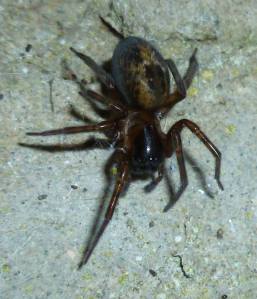 |
| Photo taken and kindly supplied by Jenni Louise Cox |
The abdomen, whilst similar in markings, is a totally different shape to Steatoda, being more oval (even in a plump female) than the False Widow’s. It is also more matte or maybe satin than the False Widow’s shiny gloss finish. The legs are slightly thicker and it doesn’t have the four dimples on top of the abdomen that characterize Steatoda. An inspection of the patterning on the abdomen will reveal it to be different to S.nobilis, more yellowy-brown than the silver-white of the Noble False Widow. Nonetheless, Amaurobius is the second most frequently misidentified spider and I have seen all too many that have been killed based upon False (Widow) assumption.
3. Araneus sp. featuring Araneus diadematus, The Common Garden Spider
 |
| The classic Garden Spider pose: Photo taken and kindly supplied by Jenni Louise Cox |
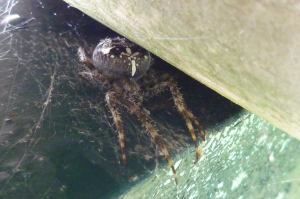 |
| A female specimen awaiting prey. Photo taken and kindly supplied by Jenni Louise Cox |
4. Tegenaria sp. featuring Tegenaria domestica, the Common House spider
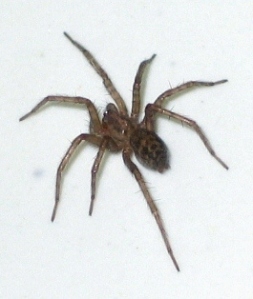 |
| Tegenaria domestica, the one you see scurrying across the kitchen floor, is also inclined to get stuck in baths. Tegenaria domestica; © 2004 by M. Betley (creative commons) |
5. Segestria sp. featuring Segestria senoculata, the Snake Backed Spider
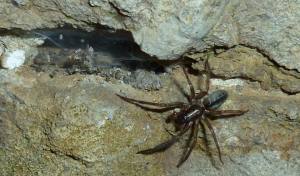 |
| Photo taken and kindly supplied by Jenni Louise Cox |
Segestria doesn’t crop up all that often, most likely because it is somewhat reclusive (though not a Recluse spider). The genus is known largely as the Tube Web spider, from its tendency to hide in tubular retreats in walls. It is one of the larger species in the UK and rather impressive-looking, with large mouth parts (or chelicerae) which in the case of S.florentina are an iridescent green! On the whole Segestria doesn’t really resemble Steatoda; the abdomen is somewhat elongated and the patterning is different. In the case of S.senoculata the pattern resembles that of an Adder, which gives it its common name. In most Segestria, however, the patterning is a noticeably darker.
That said, it is not entirely outside the realms of possibility that someone could mistake this for a Steatoda of some description, especially if they encountered a gravid female, and it is for this reason that I have included the genus here. Segestria has been known to deliver a painful but otherwise harmless bite to humans, and should in no way be regarded as dangerous.
6: Nuctenea sp. featuring Nuctenea umbratica, the Walnut Orb Weaver Spider.
Similar to Araneus – indeed, until reclassified it was to be found in that genus – The Walnut Orb Spider has a vaguely triangular dark brown body and is found on large circular webs. It lacks the cross of A.diadematus but otherwise resembles a duller example of that specimen. One noticeable difference is that it is flatter in profile, allowing it to secrete itself in crevices whilst it waits for unsuspecting prey to blunder into its web. Indeed, umbratica means ‘living in the shadows’ in Latin. Some examples do have slightly lighter patterning and it is another species that could be mistaken for Steatoda. However, apart from sharing the four depressions on the abdomen they share little resemblance.
No, despite its common name, T.sisyphium was not named after a large chain of stores selling baby products; rather for its characteristic of tending to its young after they are born and feeding the hatchlings -not a common behaviour for true spiders. Sadly I have never seen one amongst the many arachnids I have been asked to ID, but I am including it as it does bear some resemblance to S.nobilis. T.sisyphium is, in my humble opinion, another example of a quite beautiful UK species.
With striking markings, this small species belongs to the aforementioned Theridion genus, which contains over 600 known species. this in turn is part of the family Theridiidae (over 2,200 species) which also contains the Lactrodectus and Steatoda genera – the Widow and False Widow spiders of recent interest. As you might expect, it does share many characteristics with these genera, round abdomen and lengthened forelegs amongst them. It is, however, much smaller and more heavily patterned than Steatoda nobilis, with a wonderful marbling and mottled colouration varying from tans and creams to white. Should you be lucky enough to see one, please don’t kill it, enjoy it and know that I am somewhat jealous!
7: Theridion sp. featuring Theridion sisyphium, the ‘Mother Care’ spider
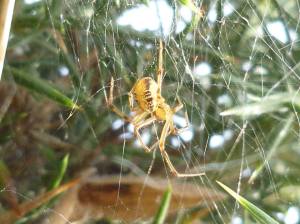 |
| Theridion Sp. likely T.sisyphium. Photo taken and kindly supplied by Jenni Louise Cox |
With striking markings, this small species belongs to the aforementioned Theridion genus, which contains over 600 known species. this in turn is part of the family Theridiidae (over 2,200 species) which also contains the Lactrodectus and Steatoda genera – the Widow and False Widow spiders of recent interest. As you might expect, it does share many characteristics with these genera, round abdomen and lengthened forelegs amongst them. It is, however, much smaller and more heavily patterned than Steatoda nobilis, with a wonderful marbling and mottled colouration varying from tans and creams to white. Should you be lucky enough to see one, please don’t kill it, enjoy it and know that I am somewhat jealous!
Steatoda
So after all these innocent bystanders, let’s get to the real thing – the False Widow. I will feature the three main Steatoda species commonly found in the UK, culminating with S.nobilis itself.
More than any other False Widow spider, S.bipunctata resembles the infamous Black Widow. She is dark brown, bulbous in abdomen, and generally uniform in colour, although light variants with a small pale dorsal line exist. As with all Steatoda there are four giveaway dimples on top of a very smooth and round abdomen. The legs are longer at the front and these are rather small measuring no more than 3cm or so. Despite their resemblance to Black Widows, S.bipunctata are harmless by comparison.
S.bipunctata – The Rabbit Hutch spider
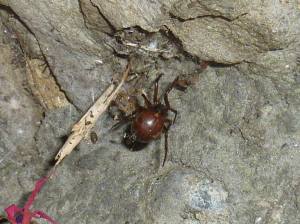 |
| Photo taken and kindly supplied by Jenni Louise Cox |
S.grossa. – The False Widow Spider or cupboard spider
 |
Mature Male Steatoda grossa: Photo: Creative Commons License :Algirdas, 2005, Lithuania. Note that this is a male specimen, evidenced by the slighter build and enlarged pedipalps.
|
S.grossa looks a little like S.nobilis and has a similar bite, akin to a nasty bee sting that some may react adversely to. It has fewer markings than its close relation S.nobilis,normally looking like a series of arrows on the abdomen, and the distinctive anterior abdominal band. Want a bit of trivia? A painted S.grossa was used in Sam Rami’s Spiderman film as the spider that bit Peter Parker (note: the author does not wish to imply that spider bites may bestow superpowers. Unfortunately.)
S.nobilis – The Noble False Widow.
Which brings us to the beastie that everyone was so worked up about in the first place, the Noble False Widow spider. S.nobilis are small, averaging 2-5cm, with smooth-looking legs that are noticeably longer at the front. They generally have a large bulbous abdomen with a pale band round the front and a marking on the top that can variously resemble a skull, a trident, or other patterns dependent upon individual. Once you know what you are looking for, they are very distinctive and easy to spot. They are fairly clumsy when off their web and will retreat from any disturbance.
Males are generally more diminutive, with proportionally smaller abdomens and, if mature, enlarged pedipalps. Even once you have positively identified S.nobilis, there is no need to kill it. A glass and card can be used to safely remove the spider, should you be so inclined, or you can just leave it be and let it continue providing you a service by eating flies and other disease-carrying insects. S.nobilis will not bite unless provoked (like being caught against skin in clothing) even then the bite should be no worse than a nasty bee sting. I’ll say it again one more time and this time paraphrase the great Douglas Adams in my description. DON’T PANIC – MOSTLY HARMLESS. Ignore the nonsense the papers are spouting. S.nobilis has never killed anyone, nor has it eaten any flesh. They have been here for 140 years and are not a new species in the slightest. I have written multiple articles and even made a video in which I handle a specimen.
Hopefully this guide will stop people assuming every spider they see is a Steatoda. We are blessed with a great number of spider species in the UK, each of which forms a vital part of our ecosystem. Without our eight-legged friends we would be overrun with disease-carrying insects and in a far worse state all round. So the next time you see a spider, don’t be alarmed. If you need to remove it, do so using the tried and tested glass and card method and deposit it outside. Spiders are phenomenally adaptive and resourceful creatures and really do not deserve the levels of fear and danger which they have accrued. I will, in time be producing one final article in which I will discuss ways for people to try to overcome their fear of spiders, which is often irrational and based upon misunderstanding and misinformation, though often through no fault of their own. Until then, happy spider spotting!
Males are generally more diminutive, with proportionally smaller abdomens and, if mature, enlarged pedipalps. Even once you have positively identified S.nobilis, there is no need to kill it. A glass and card can be used to safely remove the spider, should you be so inclined, or you can just leave it be and let it continue providing you a service by eating flies and other disease-carrying insects. S.nobilis will not bite unless provoked (like being caught against skin in clothing) even then the bite should be no worse than a nasty bee sting. I’ll say it again one more time and this time paraphrase the great Douglas Adams in my description. DON’T PANIC – MOSTLY HARMLESS. Ignore the nonsense the papers are spouting. S.nobilis has never killed anyone, nor has it eaten any flesh. They have been here for 140 years and are not a new species in the slightest. I have written multiple articles and even made a video in which I handle a specimen.
Hopefully this guide will stop people assuming every spider they see is a Steatoda. We are blessed with a great number of spider species in the UK, each of which forms a vital part of our ecosystem. Without our eight-legged friends we would be overrun with disease-carrying insects and in a far worse state all round. So the next time you see a spider, don’t be alarmed. If you need to remove it, do so using the tried and tested glass and card method and deposit it outside. Spiders are phenomenally adaptive and resourceful creatures and really do not deserve the levels of fear and danger which they have accrued. I will, in time be producing one final article in which I will discuss ways for people to try to overcome their fear of spiders, which is often irrational and based upon misunderstanding and misinformation, though often through no fault of their own. Until then, happy spider spotting!

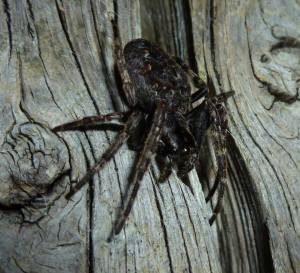
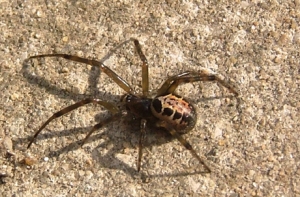

No comments:
Post a Comment